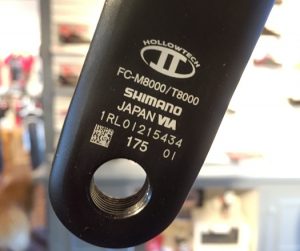Why Your Mountain Bike Crank Length is Likely Too Long
 With few exceptions, most XC and Trail oriented mountain bikes shipped today come with 175mm cranks. While some brands spec 170mm cranks, it is often only on their smallest sizes. However, the evidence leans towards mountain bike crank lengths being too long in general. Why are current lengths not optimal for many riders and why isn’t anyone doing anything about it? Good questions. I only have answers to the first.
With few exceptions, most XC and Trail oriented mountain bikes shipped today come with 175mm cranks. While some brands spec 170mm cranks, it is often only on their smallest sizes. However, the evidence leans towards mountain bike crank lengths being too long in general. Why are current lengths not optimal for many riders and why isn’t anyone doing anything about it? Good questions. I only have answers to the first.
Why are Short Cranks Better on a Mountain Bike?
Here are some reasons why shorter mountain bike cranks should become the norm.
- You don’t have to be Rachel Atherton to know how often cranks and pedals can strike the ground on high sag/low BB height trail/enduro based mountain bikes. With wide platform pedals, it isn’t hard to touch down once or twice even on some of the easier mountain bike trails around me in Vermont. Cranks striking the ground is not a good thing. You may not need a higher bottom bracket as much as you need a shorter crank…
- While shorter cranks do create slightly higher gearing, shorter cranks accelerate through the top and bottom of the stroke faster than longer cranks.
- There is no tangible maximal power loss to shorter cranks. One of the most respected researchers in cycling mechanics, Dr. Jim Martin, studied this very topic and published the results in 2001. https://www.cervelo.com/en/engineering-field-notes/a-new-spin-on-crank-length. The bottom line is that most riders will not give up any power riding a shorter crank and many will actually gain a little.
- Muscle Balance. I know I’m likely to get arguments on this one in particular, but if you truly want to maximize your power and efficiency, you want to develop a high cadence. Don’t want to believe me, talk to an exercise kinesiologist about the cadence characteristics that tend to define the most powerful and efficient cyclists.
Shorter cranks don’t increase your power on their own, but they do make developing a powerful high cadence stroke and accessing a broader range of muscle groups easier. In turn, this makes developing higher levels of sustainable power easier and creates more consistent traction.
http://www.pezcyclingnews.com/toolbox/power-output-and-cadence-learning-from-the-pros/#.Wb1FSciGOUk
https://breakingmuscle.com/fitness/big-power-does-not-require-big-gears
- Reduced Joint Load. Shorter cranks put less torque and load on joints and muscles, thus reducing the chances of knee, hip, back and other pain while riding your mountain bike.
- The first mountain bikes were built from pirated road bike parts. Mountain bike crank length was simply transferred from whatever road bikes were using in the ‘80’s and haven’t changed much since. Road bike cranks are available in a lot more lengths than they were in 1985…
So, Why Aren’t There Shorter Cranks on Mountain Bikes?
- Bike manufacturers need to start asking/insisting on more crank length options to be available if component manufacturers are going to start building them. I don’t think any/many bike
 manufacturers are asking. They should. I bet a bike where the crank doesn’t strike the ground on a demo ride sells better than one that does.
manufacturers are asking. They should. I bet a bike where the crank doesn’t strike the ground on a demo ride sells better than one that does. - Not enough riders are asking for it. Just because we get used to something (like a certain length crank) doesn’t mean it is optimal.
Pro riders and bike manufacturers need to be the impetus that drives the change to shorter crank possibilities for XC and trail mountain bikes. While a few months of muscle adaptation may be required before the full benefit is realized, I encourage many pro mountain bike riders (especially those on the shorter side) to try a shorter crank. I would not limit this to just smaller riders either; a number of Team Sky’s pro road riders used shorter cranks this year on the road.
And to bike manufacturers, I ask why a 170mm crank on a 48cm road bike is almost universally considered unacceptably long today and the same is not true on mountain bikes?
Dogma is the Death of Innovation
Treating things as dogma goes against the spirit of innovation that has been a hallmark for the bicycle industry since before the Wright Brothers. A spirit that always looks for ways to improve the experience and the performance of riders.
For an industry that has put so much effort into changing axle or bottom bracket dimensions by a few mm, the laissez faire attitude on something that can potentially improve how a bike and rider perform as much as crank length seems strange. The time for shorter XC/Trail MTB crank length options is more than here.
